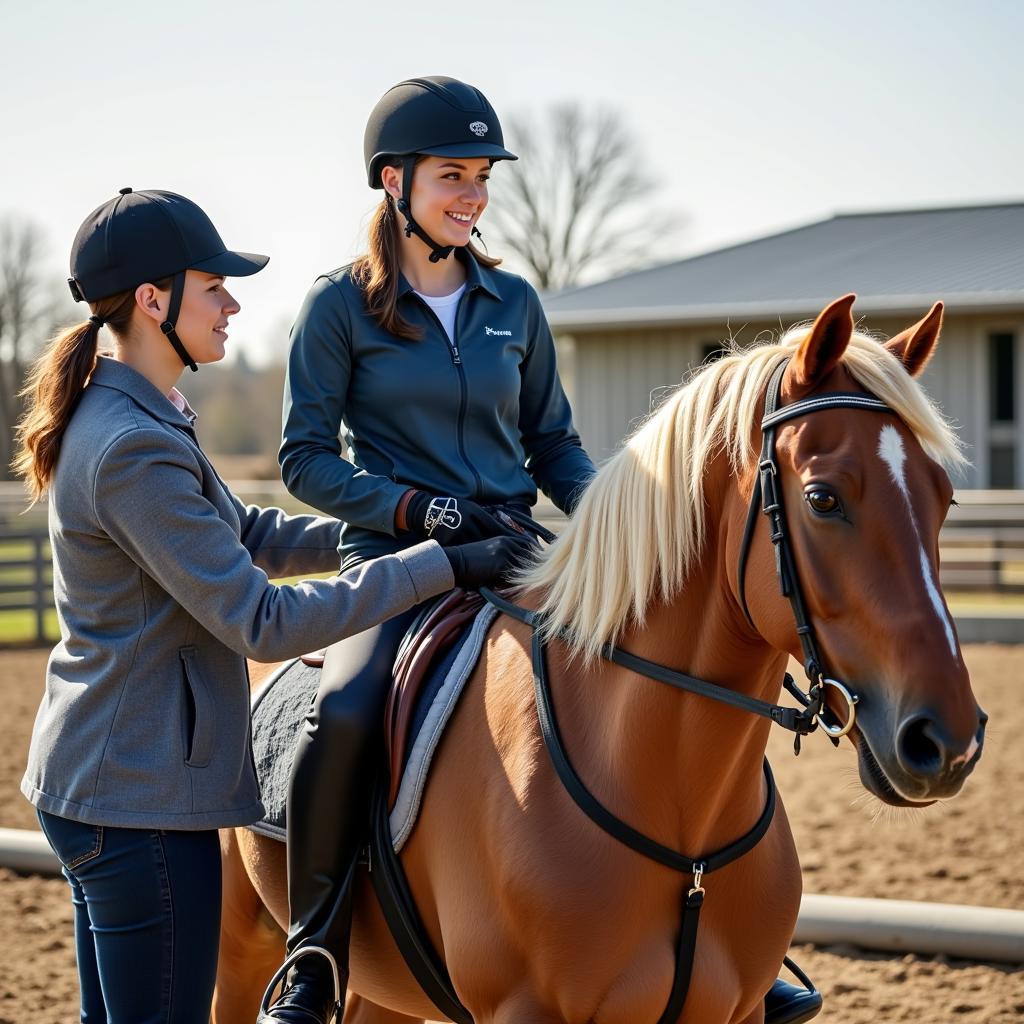Getting Back On The Horse after a setback, whether physical or emotional, can be daunting. It requires courage, determination, and a renewed sense of purpose. This article will explore the various aspects of getting “back on the horse,” from recovering from riding injuries to regaining confidence after a fall, and even addressing the broader metaphorical meaning of overcoming life’s challenges.
Understanding the “Back on the Horse” Concept
“Back on the horse” is a powerful idiom that resonates with anyone who has faced adversity. It speaks to the resilience of the human spirit and the importance of perseverance. While often used in the context of horseback riding, its application extends far beyond the equestrian world, encompassing everything from career setbacks to personal struggles. After a negative experience, it’s natural to feel apprehensive. However, the sooner you confront your fears and “get back on the horse,” the faster you can reclaim your confidence and move forward. What does “back on the horse” mean to you? Is it about conquering a fear, restarting a hobby, or simply picking yourself up after a fall?
Physical Recovery: Returning to Riding After Injury
Returning to riding after an injury requires careful consideration and a gradual approach. Consult with your physician and physical therapist to develop a rehabilitation plan tailored to your specific needs. Can a sway back horse be corrected is a helpful resource for riders who may be concerned about their horse’s physical condition. Remember, rushing the process can lead to further injury and prolong your recovery time. Focus on rebuilding strength, flexibility, and balance before attempting to ride again.
Steps to a Safe Return
- Medical Clearance: Obtain clearance from your doctor before resuming any riding activities.
- Physical Therapy: Engage in regular physical therapy sessions to regain strength and mobility.
- Start Slow: Begin with short, gentle rides on a calm and reliable horse.
- Listen to Your Body: Pay attention to any pain or discomfort and adjust your riding accordingly.
- Progressive Increase: Gradually increase the duration and intensity of your rides as your fitness improves.
“Patience and persistence are key when recovering from a riding injury. Don’t compare your progress to others, and celebrate every milestone, no matter how small,” advises Dr. Emily Carter, DVM, specializing in equine sports medicine.
Mental Recovery: Overcoming Fear and Regaining Confidence
Fear and anxiety can be significant obstacles to getting back on the horse after a fall or negative experience. Acknowledging these feelings is the first step toward overcoming them. What is swayback in horses offers insights into common equine conditions, which can sometimes contribute to rider anxiety. Visualization techniques, deep breathing exercises, and positive self-talk can help manage anxiety and rebuild confidence. Consider working with a sports psychologist or riding instructor who specializes in helping riders overcome fear. Remember, setbacks are a natural part of the learning process.
Building Confidence Brick by Brick
- Set Realistic Goals: Start with small, achievable goals and gradually work your way up to more challenging rides.
- Positive Affirmations: Use positive self-talk to reinforce your confidence and dispel negative thoughts.
- Supportive Environment: Surround yourself with supportive friends, family, and fellow riders.
- Professional Guidance: Seek professional help from a therapist or riding instructor if needed.
 Rider and instructor working together
Rider and instructor working together
“Fear is a natural response to a perceived threat, but it doesn’t have to control you. By facing your fears head-on, you can regain your confidence and rediscover the joy of riding,” says renowned equestrian coach, Sarah Johnson. Crazy horse leather backpack is a popular choice for many riders. Remember, taking a break or switching disciplines can be part of getting back on the horse. Perhaps exploring trail riding, dressage, or even back cinch horse riding might reignite your passion.
Beyond Riding: Applying the Metaphor to Life’s Challenges
The concept of “getting back on the horse” transcends the equestrian world. It’s a universal metaphor for resilience and perseverance in the face of adversity. Whether you’re dealing with a career setback, a personal loss, or any other challenge, the principles of getting back on the horse apply. Identify your fears, develop a plan, seek support, and take that first step towards moving forward. 1960s rocking horse evokes nostalgia and simpler times. Remember, every experience, positive or negative, is an opportunity for growth and learning.
Conclusion: Embracing the Journey Back
Getting back on the horse is a journey, not a destination. It requires courage, patience, and a willingness to embrace the challenges along the way. By focusing on your strengths, seeking support, and celebrating your progress, you can overcome any obstacle and rediscover your passion. Remember, getting back on the horse isn’t just about overcoming a setback; it’s about reclaiming your power and moving forward with renewed purpose.
FAQ
- How can I overcome my fear of falling?
- What are some tips for regaining confidence after a riding accident?
- How do I know if I’m physically ready to ride again after an injury?
- What are the benefits of working with a riding instructor or sports psychologist?
- How can I apply the “back on the horse” metaphor to other areas of my life?
- What are some exercises I can do to improve my balance and strength for riding?
- Where can I find a supportive community of riders?
For assistance, please contact us at Phone Number: 0772127271, Email: [email protected], or visit our address: QGM2+WX2, Vị Trung, Vị Thuỷ, Hậu Giang, Vietnam. We have a 24/7 customer service team.